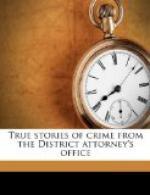Of course, if one answered all the letters one gets from the Tombs it would keep a secretary busy most of the working hours of the day, and if one acceded to all the various requests the prisoners make to interview them personally or to see their fathers, mothers, sisters, brothers, sweethearts and wives, a prosecutor might as well run an intelligence office and be done with it. But as I re-read the note I began to have a sneaking feeling of curiosity to see what Charles Julius Francis de Nevers looked like, so I departed from the usual rule of my office, rang for a messenger and directed him to ascertain the full name of the prisoner from whom the note had come, the crime with which he was charged, and the date of his incarceration, also to supply me at once with copies of the indictment and the complaint; then I instructed him to have De Nevers brought over as soon as he could be got into shape.
I had almost forgotten that I was expecting a visitor when, a couple of hours later, an undersized deputy-sheriff entered my office and reported that he had a prisoner in his custody for whom I had sent to the Tombs. Glancing up from my desk I saw standing behind his keeper a tall and distinguished-looking man in fashionably cut garments, whose well shaped head and narrow face, thin aquiline nose, and carefully trimmed pointed beard seemed to bespeak somewhat different antecedents from those of the ordinary occupant of a cell in the City Prison. I should have instinctively risen from my chair and offered my aristocratic looking visitor a chair had not the keeper unconsciously brought me to a realization of my true position by remarking:
“Say, Counsellor, I guess while you’re talking to his nibs I’ll step out into the hall and take a smoke.”
“Certainly,” said I, glad to be rid of him, “I will be responsible for the—er—prisoner.”
Then, as the keeper hesitated in putting his suggestion into execution, I reached into the upper right-hand drawer of my desk, produced two of what are commonly known in the parlance of the Criminal Courts Building as “cigars” and handed them to him.
“Well,” said I, after the keeper had departed closing the door behind him and leaving the visitor standing in the middle of the office, “I have sent for you as you requested and shall be glad to hear anything you have to say. Of course any communication which you may see fit to make to me is voluntary and, in the event for your trial for—er—any crime with which you may be charged, may be used against you.” I had a certain feeling of embarrassment in making this customary declaration since the whole idea of this person being a criminal was so incongruous as to put a heavy strain on one’s credulity. However, I recalled that a certain distinguished Englishman of letters has declared “that there is no essential incongruity between crime and culture.” He acknowledged my remark with a slight smile of half-amused deprecation and with a courteous bow took the seat to which I motioned him.




